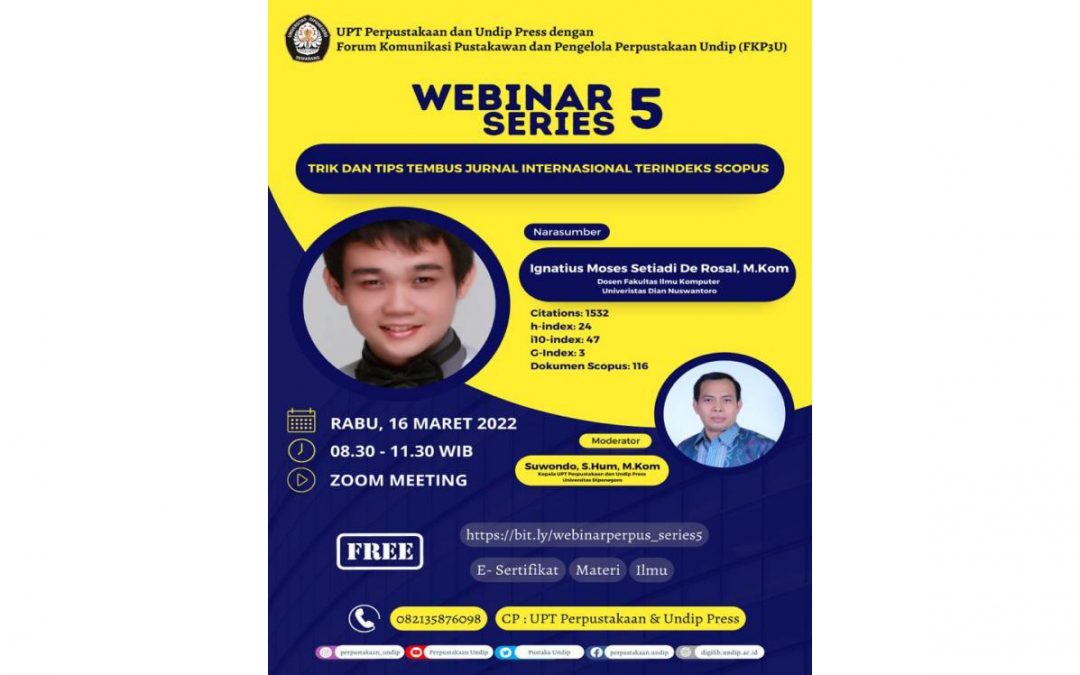Semarang (16/3) – As an effort to improve services to users, UPT Library and Undip Press of Diponegoro University in collaboration with the Undip Librarian and Library Management Communication Forum (FKP3U) held a virtual training on Webinar Series 5 with theme “Tricks & Tips to Produce Scopus Indexed International Journals”. The event was filled with enthusiasm, evidenced by the number of participants, approximately 660 people consisting of students, lecturers, librarians and the public, as reported at the beginning of the event by Pujo Winarno, S.Kom. as the Chair of FKP3U.
The opening remarks were stated by Suwondo, S. Hum., M. Kom. on behalf of Undip Vice Rector III for Communication and Business, Prof. Budi Setiyono, S.Sos., M.Pol.Admin., Ph.D who was unable to attend. He conveyed the importance of scientific publications in quantity and quality, starting at the undergraduate, masters, and doctoral levels up to the lecturer level, on a national or international scale to develop science and technology as well as to increase the nation’s competitiveness. A very interesting topic to discuss is how to produce Scopus indexed international journals with a competent resource person, Ignatius Moses Setiadi De Rosal, M.Kom. (Lecturer of Informatics Engineering Study Program, Faculty of Computer Science, Dian Nuswantoro University) who will provide inspiration and broader knowledge.
The resource person stated that Scopus is one of Elsevier’s journal indexing institutions which is used as a standard requirement for completing Ph.D. Not all journals are indexed in Scopus, even Scopus indexed journals are far less than non-indexed journals. For a work to be published as Scopus journals is not easy, if you are not familiar with the publication style. Tips on how to start publishing are by understanding individual problems and looking for solutions. Among them the lack of motivation and intention; not feeling confident; having no experienced mentors, fear of rejection, no ideas; language, funds/capital; too perfectionist; pressure of must pass requirements immediately; and restrictive rules from the promoter/supervisor.
The suitable contents for Scopus journal publications, of course, journal contents that have a clear problem (hypothesis); have a contribution/novelty (generally in research paper methods, in-depth analysis in review papers); explain in detail and interestingly; have a comparison so that contributions are easier to measure (using public datasets or replica methods) especially in quantitative research in the field of computers and engineering; have a quality bibliography (the majority have the same or better quality than the journal in question).
The presenters explained things that need to be considered in choosing a journal, including adjusting research topics with AIM and SCOPE of Journals (make sure to do a search on the journal archive of articles that have the same topic; make sure the journal is indexed by Scopus, check on ScimagoJR and scopus.com); make sure the journal is not a predator (check https://beallslist.net/); ensure APC is within your budget (many Scopus journals are free, generally the big publishers belonging to Elsevier/Springer/Emerald/etc have a free publish option with subscription mode); if the journal will be used as a condition for applying for LK or GB, you can check at https://pak.kemendikbud.go.id/portalv2/jurnal-yang-harus-dihindari/ or https://pak.kemdikbud.go.id/portalv2/jurnal-yang-direkomendasi/
Likewise, conditions when submitting journals need to pay attention to some conditions including the manuscripts that are in accordance with the author’s guideline and (if any) journal templates; preparing cover letters if necessary; ensuring the accordance of the aim and scope of the journal; and ethically the journal should not be submitted to two or more journals. Furthermore, Ignatius Moses Setiadi De Rosal, M.Kom explained, “the flow of the journal publication process starts from the author to the editor (submission), then the editor to the reviewer (passes the preview). If it is rejected, then the reviewer (ideally two or more reviewers) will return it to the author. If it is accepted, it will be handed to the production journal and if there is a revision, make a revision according to the comments. Later, it will be proofread until it is published.”
“It is necessary to be careful when choosing a journal, especially if the Scopus indexed journal is not from a well-known publisher but does broadcast calls for paper; a journal that promises a very fast and paid review process; journal content is inconsistent (prone to discontinue/cancelled), only indexed by Scopus and then quickly increases the number of issues abnormally or has many special issues (prone to discontinue/cancelled); journals with multi-disciplines,” he explained. (Diah – Public Relations).

